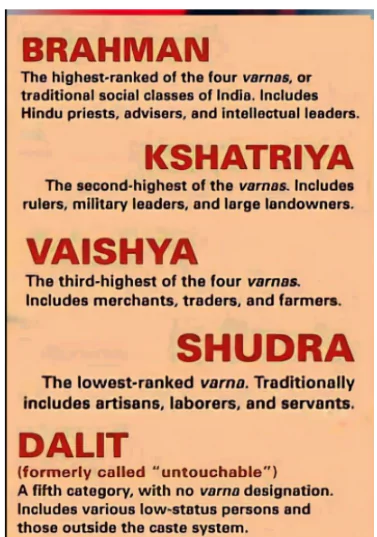Introduction:
During the Later Vedic Period (1000-600 BCE), Indian society was structured into varnas (social classes) with Brahmins, Kshatriyas, Vaishyas, and Shudras. Social mobility was limited, but rituals, trade, and agriculture played pivotal roles in shaping societal dynamics.
Characteristic Features

- Social stratification through the varna system became more established. It categorised people into four main varnas: Brahmanas, Kshatriyas, Vaishyas, and Shudras.
- Teaching was seen as the occupation of the Brahmanas. The wives of Brahmanas and cows were given important status.
- Rajanya refers to kshatriyas, and they were the warriors and rulers who received ‘Bali’ as tax.
- Striking changes took place in the Varna System. There was an increase in the privileges of the Brahmanas and the Kshatriyas.
- In the Panchavimsa Brahmana, the Kshatriya is placed first, higher than the Brahmana, but in the Satapatha Brahmana, the Brahmana is placed higher than the Kshatriya.
- The king asserted his authority over the three varnas. The Aitreya Brahmana refers to the Brahmana as the seeker of support, and he could be removed by the king from his position.
- Emphasis on sacrificial rituals increased, which enhanced the influence and power of the Brahmanas.
- The Kshatriyas challenged Brahmanical supremacy and their exclusive privilege of entering the ashrams, a regulated four-stage life, namely Brahmacharya, Grihastha, Vanaprastha and Sanyasa. The outcome of this was the birth of Jainism, Buddhism and Ajivakam.
|
- The concept of ashramas, referring to various stages of life, was not well established at this time. While brahmacharya, grihastha and vanaprastha are mentioned, sannyasa had not developed.
- The concept of Dvija (twice-born) developed during this period.
- Upanayana (sacred thread) was limited to the upper sections of society. This ceremony marked the initiation of education. The fourth varna was denied this privilege, and the Gayatri mantra could not be recited by the Sudras. Women were also denied the upanayana and Gayatri mantra.
- Certain craft groups managed to attain higher status:
- The Rathakaras, the chariot makers, had the right to wear the sacred thread.
- Vaisya referred to the common people. They were involved in agriculture, cattle breeding and artisans. Later, they became traders. Vaisyas paid taxes to the kings.
- Some social groups were placed in ranking even below the Sudras.
Enroll now for UPSC Online Course
| Chandala were a group within Panchamas (fifth varna) who were excluded from the varna system. They were considered the untouchable class. |
- The society was predominantly rural, but urbanism began to show traces towards the end. Mentions of towns (nagar) can be found in texts like Taittiriya Aranyaka.
Family Structure
- The family was an important social unit. The family was patriarchal with patrilineal descent. The relations within the family were hierarchical. Polygyny (taking many wives) was prevalent.
- The household became more structured, which means it became more organised. Several household rituals were also developed for the welfare of the family. The married man with his wife was the Yajamana.
- Joint families with three or four generations residing together.
- Western Uttar Pradesh sites of Atranjikhera and Ahichchhtra reveal communal food preparation with large family units.
- The idea of gotra emerged in the Later Vedic Period Society. Gotra literally meant ‘cowpen’, and it referred to a group of people from a common ancestor. Persons of the same gotra were considered brothers and sisters and could not intermarry.
- Several unilineal descent groups existed with common ancestors. Several related clans formed the tribe.
- Marriages between individuals of the same gotra were prohibited. Chandrayana was a penance for men marrying women of the same gotra.
Status of Women
- A decline in the societal stature of women compared to the Rig Vedic age was witnessed.
- No longer permitted to attend the assemblies.
- Though women had participated in rituals in the Rig Vedic period, they were excluded in the Later Vedic Period Society.
- Patriarchal family structure: Women’s roles became limited to domestic tasks.
- Practices of Sati and Child Marriage were prevalent.
- Daughters were even labelled as a source of sorrow (Aitreya Brahmana).
- However, women like Gargi and Maitreyi excelled in the domain of knowledge; Gargi outwitted Yajnavalkya in a philosophical discourse.
Conclusion
- Later Vedic Period Society saw a structured society based on varna divisions, with emphasis on rituals, agriculture, and trade.
- These elements contributed to the cultural and economic fabric, laying foundations for future developments in ancient India.
![]() April 20, 2024
April 20, 2024
![]() 4309
4309
![]() 0
0
